57 Workplace Wellness Initiative Ideas to Transform Employee Wellbeing
Last Updated Sep 17, 2025

Healthcare costs are creeping up year after year, and most employees feel disconnected from their own wellbeing at work. Sound familiar?
HR leaders everywhere are juggling rising expectations with limited resources. A once-optional wellness initiative now feels like a business necessity—and tossing out yoga sessions and fruit bowls won’t cut it anymore. Burnout is peaking. Turnover is painful. And it’s all impacting your bottom line.
But there’s a way to turn the tide. Companies that embed wellbeing into their culture aren’t just checking boxes—they’re building workplaces where people thrive. Think lower stress, higher retention, and teams that show up energized.
Transform your approach to workplace wellness initiatives with strategies designed to deliver real results.

What You’ll Learn
- Wellness is a Strategic Priority: Why employee wellness is no longer just a perk, but a measurable driver of lower turnover, higher productivity, and reduced healthcare costs – making it a must-have in your HR strategy.
- Holistic Programs Deliver Big Results: How supporting the whole employee (physical health, mental wellbeing, financial stability, and more) leads to happier, more engaged teams – and why companies with comprehensive wellness offerings see significantly higher ROI.
- 57 Actionable Wellness Initiatives: A treasure trove of practical ideas – from fitness challenges and “deskercise” sessions to mental health days and financial coaching – that you can mix and match to build a wellness program tailored to any workforce.
- Implementation Best Practices: Step-by-step guidance on rolling out your wellness strategy – including assessing employee needs, securing leadership buy-in, phasing in programs, communicating effectively, and incentivizing participation for maximum engagement.
- Measuring Impact (ROI vs. VOI): Key metrics and approaches to evaluate success. Learn which KPIs to track (participation, absenteeism, satisfaction, etc.), how to calculate Return on Investment (ROI) and demonstrate Value on Investment (VOI), and how to use data to continuously improve your initiatives.
Launch a wellness program that lifts engagement and lowers costs.
What are Workplace Wellness Initiatives?
Workplace wellness initiatives are employer-sponsored programs and policies aimed at improving employees’ health and quality of life on the job and beyond. This can include anything from physical fitness programs and mental health resources to financial counseling and flexible work arrangements – any strategy that supports employees’ overall wellbeing in a meaningful way.
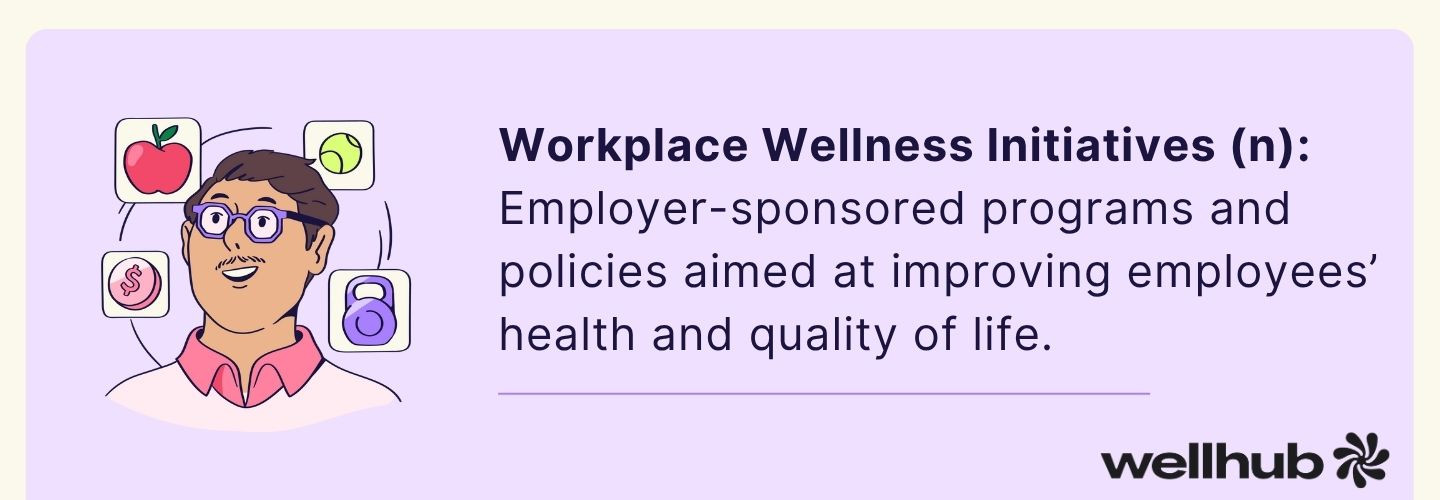
The Business Case for Workplace Wellness Initiatives
Still on the fence about prioritizing wellness? Let’s talk numbers.
Research shows that workplace wellness programs strengthen a company’s bottom line and boost competitiveness. In fact, 95% of companies that measure the ROI of wellness initiatives see positive returns – most getting at least a $2 return for every $1 spent.
Here’s how wellness drives business results:
- Reduced Turnover and Hiring Costs: Nearly all HR leaders (98%) say their wellness program has helped cut employee turnover. Considering it can cost half to two times an employee’s salary to replace them, keeping people happy and on board delivers major savings. Plus, 83% of HR pros report their wellness program is “very or extremely” important for attracting talent – in other words, great wellness benefits help draw in great people.
- Higher Productivity: Burned-out employees are about 20% less productive – costing the U.S. economy an estimated $234 billion a year in lost output. The flip side? When wellbeing is a priority, 97% of CEOs see a productivity boost on their teams, with nearly half calling the improvement major. Healthy, energized employees simply get more done.
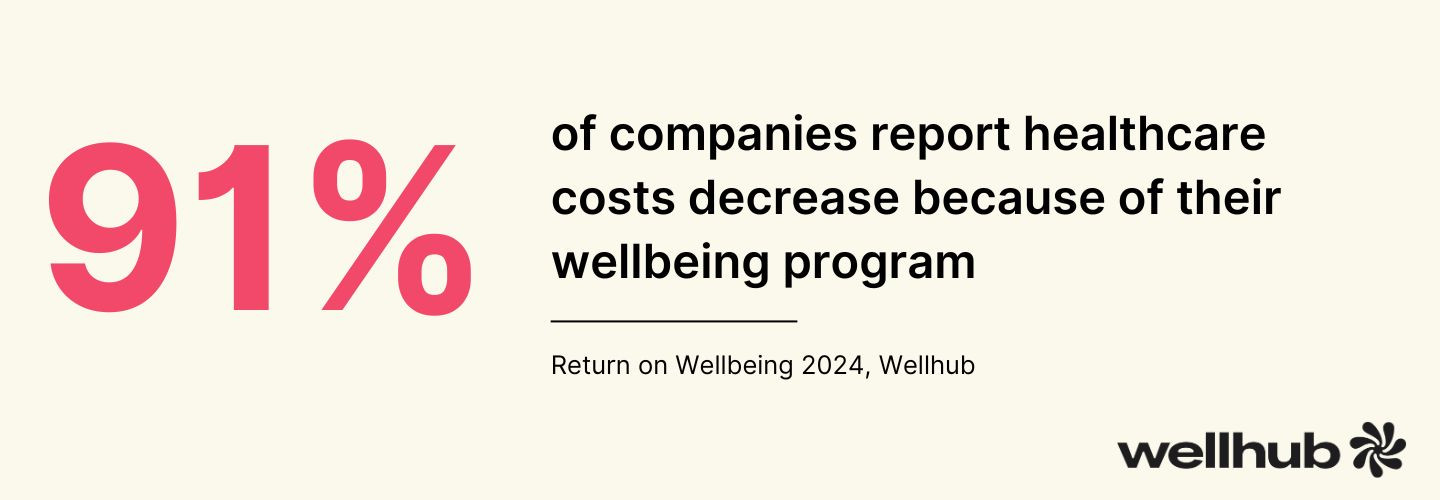
- Improved Engagement & Morale: Wellness nurtures a positive mindset.Sixty-one percent of workers with wellness benefits report being happy at their current company, versus just 36% of those without. That nearly doubled workplace happiness translates into higher morale, deeper loyalty, and employees who bring their best selves to work each day.
- Lower Healthcare Costs: Preventative care pays off. Nine in ten companies report lower healthcare costs thanks to their wellness program, and 91% of HR leaders say their healthcare benefits expenses have dropped as a result of wellness initiatives. By helping employees manage health risks and stress before they turn into claims, organizations save big on insurance and medical spend.
The verdict is clear: workplace wellness works. It’s a business strategy that protects your people and your profitability at the same time.
Now, let’s get into the fun part: how to do it.
Dive deep into how workplace wellness can make your organization more successful.
57 Actionable Ideas for Workplace Wellness Initiatives
Designing a great wellness program means addressing all facets of wellbeing.
The good news? You don’t have to start from scratch.
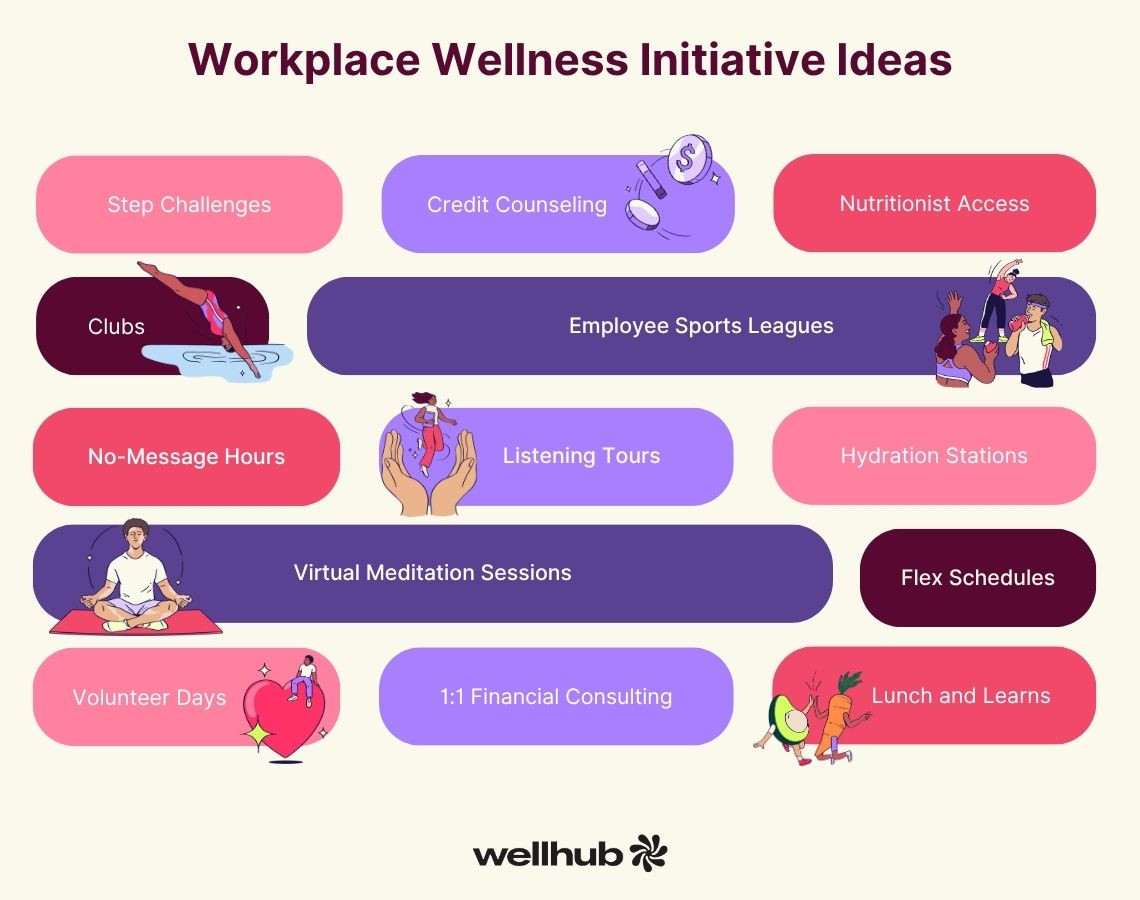
Here are dozens of actionable ideas across four dimensions of wellness to inspire your strategy. Pick a mix that fits your company culture and budget. Research shows that companies with more comprehensive wellness offerings reap greater rewards – those with four or more program areas saw significantly higher returns than those focusing on just one or two. In other words, variety and inclusivity matter. Let’s dive in!
Physical Wellness Initiatives (23 Ideas)
Let’s be honest—when your employees feel physically well, everything changes. They have more energy. More confidence. More momentum. And that shows up in the workplace, big time.
But here’s the catch: only 39% of employees say they’re physically fit, and more than half cite time constraints as their biggest blocker to working out. That’s why it’s essential to offer wellness initiatives that meet people where they are.
Here are nearly two dozen physical wellness ideas you can mix, match, and make your own:
Onsite & Virtual Fitness and Activity Programs
- Subsidize gym memberships or fitness apps — especially flexible, all-access options.
- Host onsite or virtual yoga/meditation classes to help teams stretch and reset.
- Run walking challenges with team goals, leaderboards, and mini-prizes.
- Start an employee sports league—think softball, kickball, or even dodgeball.
- Offer “deskercise” sessions with easy stretches employees can do between Zoom calls.
- Encourage walking meetings—they’re good for focus and step counts.
- Provide ergonomic assessments and offer stipends for equipment upgrades.
- Install bike racks and promote cycling to work (eco + cardio win!).
- Map walking trails near your office—or create indoor loops for all-weather movement.
- Partner with local studios for employee discounts on yoga, pilates, or spin.
- Plan “active breaks” during long meetings—stretching boosts engagement.
- Offer standing desks or converters to encourage more movement.
- Organize step challenges using wearable tech or step-tracking apps.
- Bring in chair massage pros for mini wellness days or appreciation events.
- Promote 5K charity runs or community walks and cover registration fees.
Get employees up and moving:
- 30 wellness activities that are perfect for the workplace
- 17 plug-and-play physical wellness ideas for your team
- 5 actionable employee fitness challenge ideas
Nutrition & Healthy Habits
Let’s not forget the other half of the wellness equation: food and hydration. Only 40% of employees say they eat nutritiously, and cost and time are the top two barriers to eating better.
These small, intentional moves can help employees fuel their days with purpose:
- Stock break rooms with healthy snacks—fruits, trail mix, whole grain options.
- Host healthy cooking demos that teach simple, budget-friendly recipes.
- Offer access to a nutritionist via your benefits platform or wellness partner.
- Run healthy potlucks or recipe exchanges to build community around wellness.
- Install hydration stations with filtered water and fruit infusions.
- Organize lunch-and-learns on nutrition, healthy swaps, or meal prep.
- Try “Meatless Mondays” or other wellness campaigns in your cafeteria.
- Prioritize nutritious catering for meetings and company events.

Mental & Emotional Wellbeing Initiatives (19 Ideas)
Emotional health is productivity multiplier—and a retention booster, too. Right now, 47% of employees say work stress is degrading their mental wellbeing. Even more are losing sleep over it. That makes mental wellness a mission-critical business strategy.
Whether you’re building a program from scratch or refreshing what’s already in place, here are 19 ways to foster resilience, reduce burnout, and create a more human workplace.
Mental Health Support & Awareness
- Actively promote your EAP—and make sure employees know how (and when) to use it.
- Offer teletherapy benefits to expand access to professional support.
- Provide mindfulness app subscriptions like Headspace or Calm.
- Host stress management workshops with actionable strategies.
- Train managers in mental health first aid so they know how to respond and refer.
- Create quiet spaces in the office where employees can regroup and reset.
- Share wellness resources in newsletters—think bite-sized videos, podcast recs, or mental health checklists.
- Schedule daily guided meditation sessions (just 10 minutes makes a difference).
- Promote digital detox breaks and encourage screen-free time when possible.
- Offer sleep health resources, like expert webinars or downloadable guides.
Build psychological safety with these data-backed strategies.
Work-Life Integration & Flexibility
Employees don’t stop being people when they start being professionals. And flexibility can make the difference between a burnt-out workforce and a thriving one.
- Offer flexible schedules—compressed workweeks, flextime, and start-stop hour options.
- Support remote work whenever it aligns with team goals.
- Build in wellness or mental health days outside of regular PTO.
- Encourage PTO use—and model it from the top down.
- Create boundaries for after-hours emails and Slack messages.
- Offer subsidized childcare or backup care services to ease mental load.
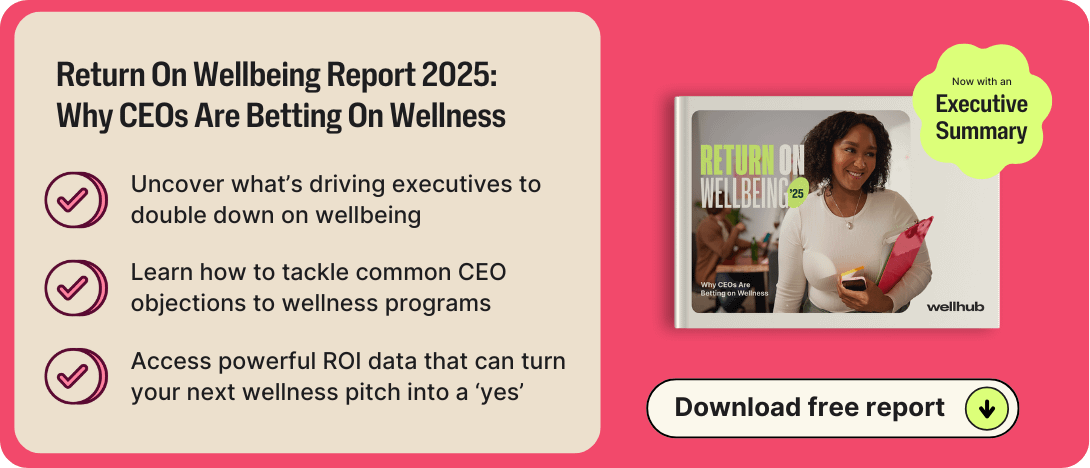
Stress Reduction & Culture Shifts
Culture sets the tone. When your workplace prioritizes empathy, openness, and psychological safety, stress naturally goes down—and satisfaction goes up.
- Promote open communication through feedback loops and listening tours.
- Train managers on empathy and burnout prevention, not just compliance.
- Celebrate employees with recognition programs that focus on impact, not just output.
Unlock 7 proven strategies to strengthen emotional wellness at work.
Financial Wellness Initiatives (10 Ideas)
Here’s the reality: 68% of employees say their financial situation is holding them back from investing in their overall wellbeing. And when people feel financially stressed, it spills into every corner of their lives—including work.
That’s why financial wellness should be more than just a retirement talk once a year. When you give your people the tools to take control of their money, you empower them to show up stronger in every part of their job.
Here are 10 initiatives to help you turn financial wellbeing into an everyday workplace benefit:
Education & Counseling
- Host financial literacy workshops on budgeting, saving, and debt reduction.
- Offer access to 1:1 financial counseling with a certified expert.
- Run retirement planning seminars that explain 401(k)s, IRAs, and long-term investment options.
- Share guidance on student loan management, including forgiveness updates.
- Provide credit counseling resources to help employees improve financial health.
Keep top talent inspired with this professional growth blueprint. [20 ideas]
Benefits & Resources
- Offer regular benefits education sessions so employees fully understand what’s available.
- Give access to budgeting and financial planning tools—apps, spreadsheets, or software.
- Launch an emergency savings program to help employees build a cushion.
- Incentivize healthy behaviors with HSA contributions, raffles, or bonuses.
- Provide employee discounts on services like tax prep, legal advice, or home insurance.
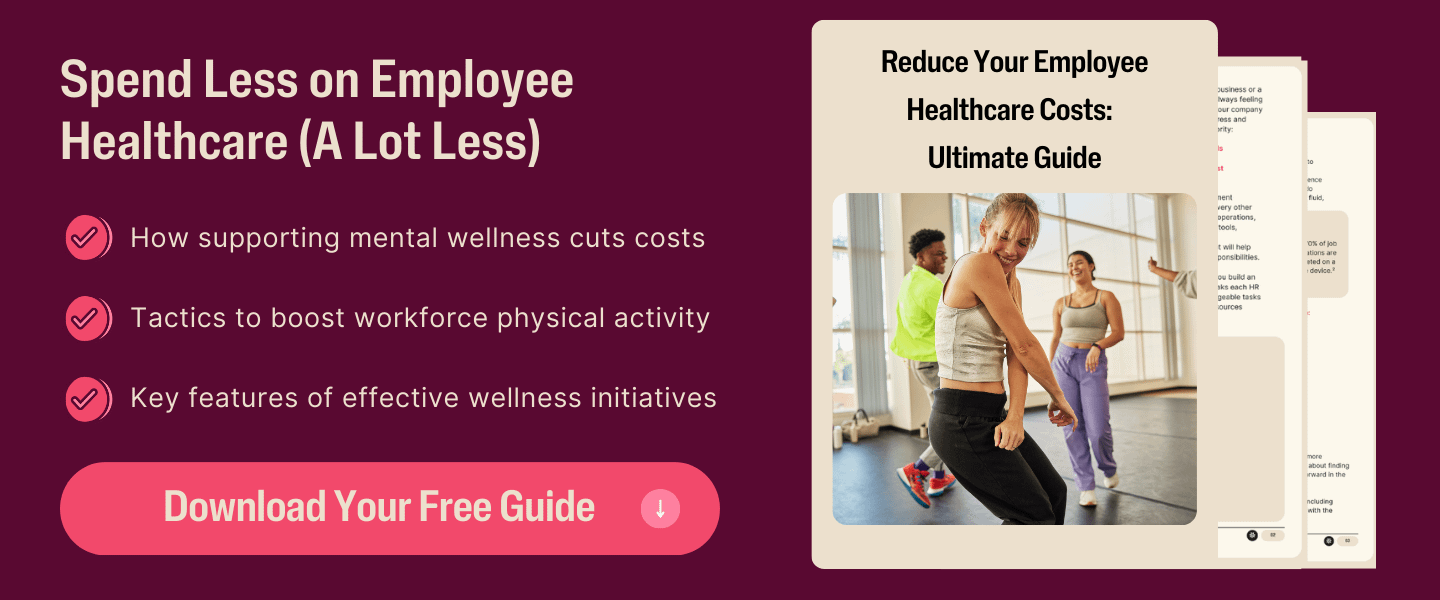
Social & Community Wellness Initiatives (5 Ideas)
Let’s bring it home with one more wellness dimension that often flies under the radar—but makes a huge difference: connection. When employees feel a sense of community at work, they’re more likely to stay, engage, and grow. But in hybrid and remote environments, that connection can slip through the cracks.
The good news? You can intentionally design opportunities for camaraderie and community. And those efforts go a long way—61% of employees with wellness programs say they’re happy at work, compared to just 36% of those without one.
Here are five actionable ideas to build social wellness into your workplace:
Team Building & Connection
- Organize employee volunteer days—whether it’s beach cleanups, food banks, or school supply drives.
- Support social clubs based on shared interests—like book clubs, cycling groups, or even fantasy football leagues.
- Plan regular team-building events that are low-pressure and fun. (Think trivia nights, escape rooms, or creative challenges.)
- Launch a mentorship program to help employees build relationships across departments and levels.
- Celebrate employee milestones publicly—birthdays, anniversaries, promotions, and personal wins all deserve the spotlight.
Implementing Your Wellness Initiatives: A Step-by-Step Guide for HR
Designing a wellness initiative is one thing: implementing it successfully is another. To ensure your wellbeing initiatives hit the mark, follow these key steps tailored for HR leaders:
- Conduct a Needs Assessment: Start by understanding what your employees truly need and want. Use surveys, focus groups, or suggestion boxes to gather input on which wellness areas matter most. Analyze data you have (e.g., health risk assessments, absenteeism patterns) for insights. This data-driven approach will help you tailor initiatives that address actual pain points – whether it’s stress, ergonomic issues, or lack of work-life balance. Plus, involving employees in the planning gives them a sense of ownership from the get-go.
- Secure Leadership Buy-In: A wellness program will gain traction only if leadership is on board. Build a compelling business case (you’ve got plenty of stats from earlier!) highlighting how wellness ties to performance, retention, and cost savings. Present to executives with clear ROI projections and employee feedback to make your case. When leaders visibly support wellness (attending events, talking about it, allocating budget), it sets the tone for the whole company. In fact, executive participation can make or break engagement – one study found employee participation jumped from 44% to 80% when the C-suite was highly engaged in the wellness program.
- Start Small and Phase In Programs: You don’t have to launch 20 initiatives at once. Prioritize a few high-impact ideas from your assessment and roll them out as a pilot. For example, you might begin with a fitness challenge and enhanced EAP services this quarter, then add financial wellness workshops next quarter. Piloting allows you to test uptake and work out kinks. Gather feedback, measure participation, and then expand the programs that resonate most. This phased approach also helps manage resources and build momentum as successes roll in.
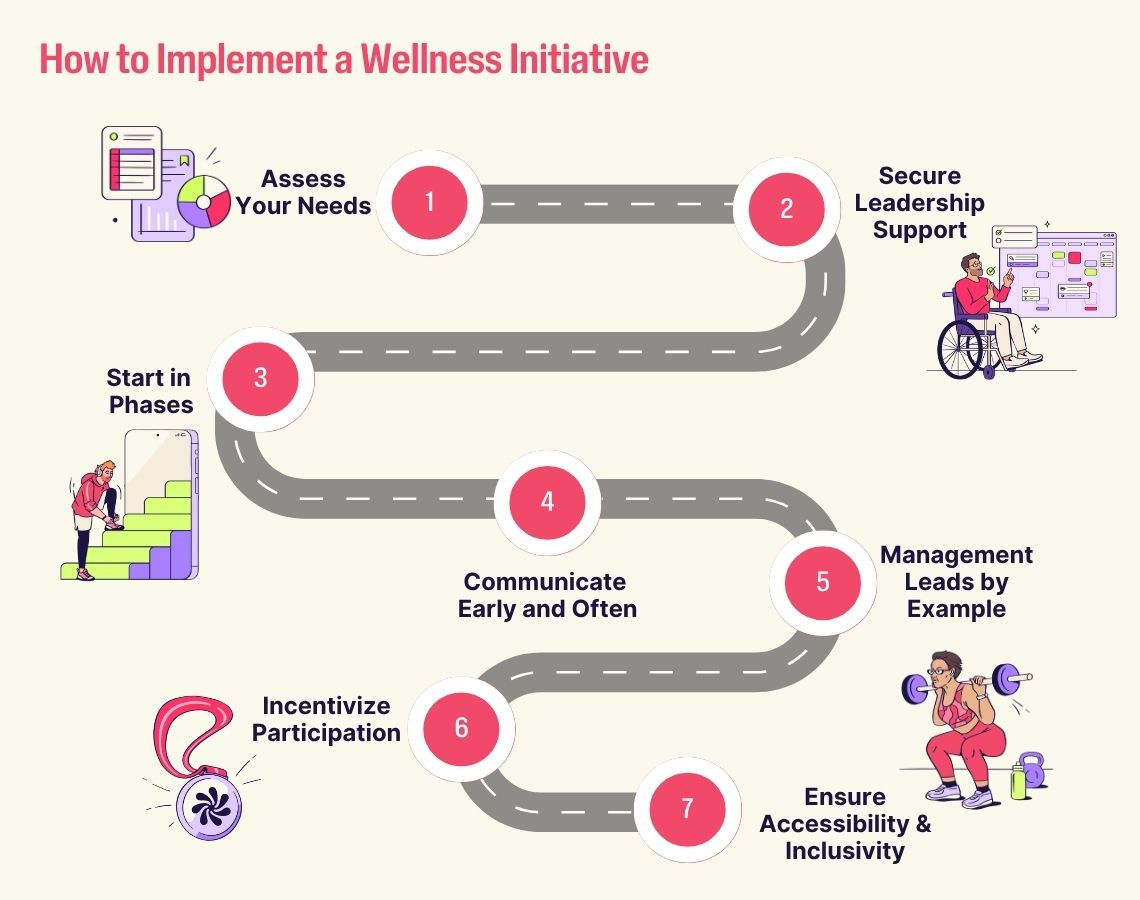
- Communicate Early and Often: Even the best wellness resources won’t help if employees don’t know about them! Develop a robust communication plan to introduce and promote your initiatives. Use multiple channels – emails, intranet, team meetings, posters in break rooms, Slack announcements – to highlight what’s available. Clearly explain the why (“We’re offering yoga classes because we heard you want stress relief and flexibility”) and the how (when, where, and how to sign up). Keep messaging positive and inclusive, and continue the drumbeat: send reminders, share success stories (“Look how Marketing increased their steps!”), and update everyone on new offerings. Effective, ongoing communication is key to sustained engagement.
- Lead by Example – Engage Managers and Leaders: Company culture flows from the top. Encourage leaders at all levels to actively participate in wellness programs and openly encourage their teams to do the same. If managers block off time for a fitness class or take mental health days themselves, employees will feel permission to do so. Consider having a senior executive champion each major initiative (e.g., the CFO joins the financial wellness seminar). Leadership’s visible commitment lends credibility and normalizes wellbeing as part of “how we do business.”
- Incentivize Participation: Let’s face it – we’re all motivated by a little extra push. Increase uptake by offering creative incentives and rewards. This could be small (company swag, water bottles, gift cards for completing a wellness challenge) or significant (an extra day off as a raffle prize for program participants, insurance premium rebates, team outings for achieving wellness goals). Peer recognition works too: celebrate top participants or teams in company communications. Gamifying wellness with challenges, badges, or friendly competition can turn engagement into a fun game rather than a chore. The key is to recognize and reward efforts, reinforcing the value you place on employees caring for their wellbeing.
- Ensure Accessibility & Inclusivity: As you implement initiatives, strive to make them accessible to all employees. That means considering remote and hybrid workers (e.g., offer virtual options for workouts or workshops), different physical abilities (modify activities so everyone can participate in some way), and varying personal circumstances. Be mindful of cultural differences or family obligations – for instance, schedule events at diverse times or record sessions for those who can’t attend live. Solicit feedback from employee resource groups or DEI councils to identify any unintentional barriers. A truly inclusive wellness program signals that every employee’s wellbeing matters, not just those who fit a certain mold. The more people who can take part, the bigger the impact on your workforce.
By following these steps, you’ll create a strong foundation for your wellness strategy. It transforms good intentions into a plan that’s tailored, supported, and well-received across your organization.
We made it easy: Launch your wellness program with this step-by-step guide.
Measuring Success: Key Metrics for Wellness Initiatives
You’ve launched some wellness programs – fantastic! But how do you know if they’re working? To justify continued investment (and to keep improving), it’s crucial to track the right metrics. Participation rates are a great start, but you don’t have to stop there.
Here’s how to approach measuring success.
ROI vs. VOI – Two Sides of the Value Coin
When evaluating wellness programs, consider both Return on Investment (ROI) and Value on Investment (VOI). ROI is the direct financial return – think healthcare cost savings or productivity gains that you can put a dollar value on. VOI includes broader benefits that are just as important but trickier to quantify, like improved morale, engagement, and company reputation.
- ROI (Return on Investment): This is about the numbers. For example, did your initiatives lead to lower medical claims or reduced turnover costs? Many companies see a strong ROI – in fact, 95% of employers tracking wellness ROI report positive returns. Over half report getting more than $2 back for every $1 spent when factoring in healthcare savings and productivity boosts. ROI metrics to look at include changes in healthcare expenses year-over-year, decreased spending on disability or sick leave, and improvements in retention that save recruiting dollars. One company might find that mental health support yielded a 6:1 ROI through fewer medical claims and absentee days. Crunching these numbers helps prove that wellness isn’t just an expense, but an investment that pays back.
- VOI (Value on Investment): Not everything that counts can be counted in dollars. VOI captures the softer, but equally crucial, outcomes of wellness programs. Did employee morale improve? Is the workforce more resilient and engaged? These factors drive performance and innovation in ways that aren’t immediately reflected on a spreadsheet. For instance, a more positive company culture might lead to better customer service or employer brand – outcomes that are invaluable long-term. Interestingly, organizations are increasingly recognizing this holistic value: 62% of companies now prioritize employee wellbeing and purpose over cost-cutting in their approach. In measuring VOI, you’ll rely on surveys, observations, and correlations (e.g., an uptick in engagement survey scores following wellness program rollout, or anecdotal feedback about improved work-life balance). VOI is about the story behind the numbers – the human impact.
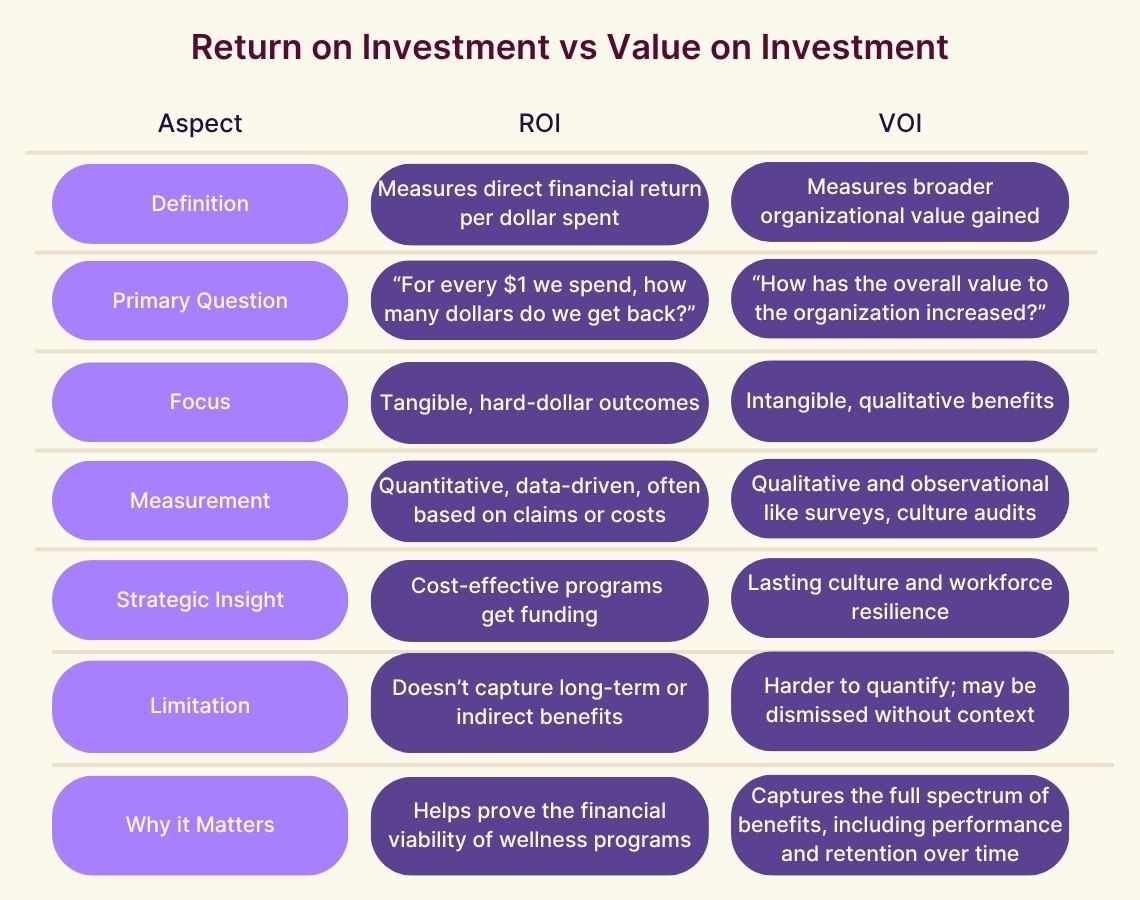
Wellness Initiative KPIs
So, what specific Key Performance Indicators (KPIs) should HR track for wellness initiatives? Here are some of the most telling metrics, and why they matter:
| KPI | Why It Matters |
| Participation Rates | This is your basic engagement metric – what percentage of employees are taking part in various programs (fitness classes, EAP counseling, financial workshops, etc.)? High participation means you’re effectively reaching your people. Low participation can flag issues (maybe scheduling conflicts or lack of awareness). Track overall wellness program uptake and drill down by initiative to see what’s popular. Remember, though: participation is just the first step; couple it with outcome metrics for full insight. |
| Employee Satisfaction & Morale | Gauging how employees feel is critical. Use surveys (annual engagement surveys, pulse checks, or wellness-specific questionnaires) to measure changes in morale, stress levels, and satisfaction. For example, an increase in your wellness program satisfaction score or a higher eNPS (employee Net Promoter Score) indicates your efforts are resonating. Happier, less stressed employees are more productive and less likely to leave, which ties directly to VOI. |
| Absenteeism & Presenteeism | These metrics show how wellness might be impacting attendance and on-the-job productivity. Absenteeism is typically measured as average sick days per employee per year – are your wellness efforts driving this down? Presenteeism (employees coming to work but not fully functioning due to health issues) is trickier to quantify, but you can use proxies like self-reported productivity or even output metrics. If you see sick days drop by, say, 20% after introducing wellness days and flu shot clinics, that’s a clear win. Fewer sick days and more engaged presence at work mean better overall performance. |
| Employee Retention Rate | Wellness can be a magnet for retention. Track your turnover rate (percentage of employees leaving annually) and see if it improves after wellness program implementation. You can also monitor retention specifically among participants vs. non-participants in programs, if data allows. A drop in turnover saves money and knowledge loss. When 98% of HR leaders say wellness programs reduce turnover, it’s worth observing those trends in your organization – especially in today’s competitive talent market. |
| Healthcare Costs | Work closely with your benefits or insurance providers to monitor trends in healthcare claims and premium costs. It may take a couple of years to see significant changes, but metrics like average per-employee healthcare cost, claim incidences (e.g., number of high-cost claims, or claims related to stress conditions), and biometric screening results (aggregate) can show if your workforce is becoming healthier. For instance, a decrease in total claims or slower growth in insurance premiums is a strong indicator that preventative wellness measures are working. Many companies indeed report such outcomes – 91% of HR leaders and 68% of CEOs say healthcare costs decrease with wellness programs. |
| Health Outcomes | If available (and always privacy-compliant), look at aggregate health metrics from voluntary screenings or wellness apps. Are employees’ average blood pressure, BMI, or cholesterol levels improving? Has there been a reduction in reported stress or anxiety levels (perhaps via periodic health risk assessments)? You might not get individual data due to privacy, but even anonymized group health stats can validate that your programs (like nutrition and fitness initiatives) are making a tangible difference. Improved health outcomes tie back to reduced healthcare costs and better quality of life on the job. |
Tracking these KPIs will give you a well-rounded picture of your wellness program’s impact. It’s important to collect baseline data before you start initiatives, so you have a comparison point. Also, consider the timeframe – some metrics (like participation or satisfaction) might show improvement within weeks or months, while others (like healthcare costs or turnover) might take a year or more to shift.
Continuous improvement is critical. Treat your wellness program as a living, evolving strategy. Regularly review the data and feedback you collect. What’s working well? Celebrate those wins and consider expanding those programs. What’s underperforming or not clicking with employees? Don’t be afraid to tweak or even sunset initiatives that aren’t delivering value. Perhaps your first try at a meditation app had low uptake – a different app or a personal touch (like live sessions) might work better. Maybe lunchtime fitness classes are packed (great!), but after-work ones fizzle – adjust schedules accordingly.
Use employee input continuously: convene a wellness committee or ambassadors from different departments who can surface ideas and improvements. Remember, the goal is progress, not perfection. By iterating on your programs with data in hand, you’ll create a culture of wellness that gets stronger each year.
Here’s how to find a whole-person wellness program that boosts performance.
Bring Your Wellness Initiatives to Life with Wellhub
One-off perks aren’t enough. Employees want real support, and HR leaders need solutions that actually move the needle on burnout, retention, and rising costs.
A comprehensive wellbeing program helps make that happen. Wellhub connects your people to personalized resources that support their physical, mental, and financial health—all in one easy-to-access platform. That kind of support pays off. Ninety-one percent of HR leaders say their healthcare costs went down after launching a wellness program.
Speak with a Wellhub Wellbeing Specialist to turn your wellness strategy into a benefit your people will use—and love.

Company healthcare costs drop by up to 35% with Wellhub*
See how we can help you reduce your healthcare spending.
Category
Share

The Wellhub Editorial Team empowers HR leaders to support worker wellbeing. Our original research, trend analyses, and helpful how-tos provide the tools they need to improve workforce wellness in today's fast-shifting professional landscape.
Subscribe
Our weekly newsletter is your source of education and inspiration to help you create a corporate wellness program that actually matters.
Subscribe
Our weekly newsletter is your source of education and inspiration to help you create a corporate wellness program that actually matters.
You May Also Like

Corporate Wellness Trends HR Must Know for 2026 | Wellhub
See the top 2026 wellness trends shaping performance, retention, and culture—plus how HR can build a unified, ROI-driven wellbeing strategy.

Wellness Points Programs: Boost Employee Health & Engagement | Wellhub
Turn your workplace wellness strategy around with a points program that rewards healthy behavior with perks, from extra time off to gift cards.

Employee Financial Wellness Programs: Ultimate HR Guide | Wellhub
Create an effective financial wellness program that supports your employees in their financial needs, boosting productivity and retention.